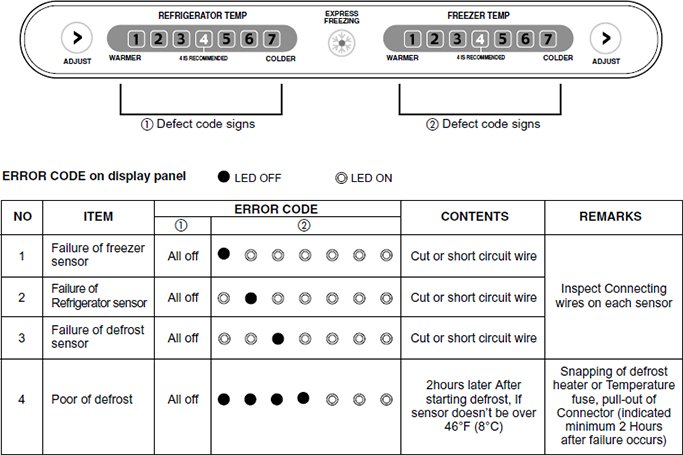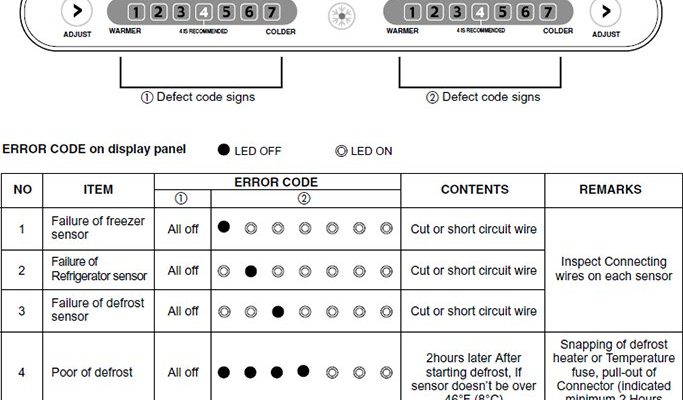
The “OE” error code on an LG refrigerator is basically its way of telling you there’s a problem with the water drainage. Think of it like a clogged sink – if the water can’t flow out, it starts to back up. In your fridge, this could mean a drain is blocked, a pipe is clogged, or there’s something more technical going on. While some of these issues you might be able to handle on your own, there are times when calling a technician is the smartest choice for a fix.
Understanding the OE Error Code
So, what’s really going on when you see the “OE” error? The code stands for “Overflow Error” and happens when the refrigerator’s drainage system isn’t working properly. Essentially, it could be as simple as ice or debris blocking the flow of water from the ice maker or defrost system. Imagine a drinking straw that’s been clogged with pieces of fruit – the water gets blocked, and suddenly nothing can get through.
In many cases, this might be due to an obstruction in the drainage system that you can clear. Sometimes, it involves a quick clean-up of the drain hole or pipe, which might be overwhelmed with ice or food particles. But the OE code can also indicate more severe problems like a malfunctioning drain pump or a kinked water line. In such instances, no amount of cleaning will help – you may need a professional to take a closer look.
Don’t fret, though. Before jumping to conclusions, it’s worth doing a simple check to see if it’s a blockage you can tackle yourself. If the issue is recurring or you find water pooling in or around the fridge, that’s usually a sign to call in the experts. Remember, not every problem needs a pro’s touch, but it’s always better to err on the side of caution.
When to Handle It Yourself
Sometimes, fixing the OE error is a bit like changing a flat tire – if you know what you’re doing and have the right tools, you can probably handle it yourself. A good starting point is to inspect the drainage system. Look for ice buildup around the drain hole, which can often be resolved with warm water. Much like clearing a clogged shower drain, you can use warm water to melt the blockage away.
Another DIY step is checking for visible food debris that might be blocking the drain. This might involve removing shelves and trays for a better view, but once cleared, it can solve the problem entirely. You can think of it like giving your fridge a little spring cleaning, which it occasionally needs to function smoothly.
However, proceed cautiously. If you start working on your fridge and feel like you’re diving into something beyond your comfort zone, it’s totally okay to step back. At any hint of doubt, or if the problem keeps coming back, it’s time to reach out for help from a professional technician.
Knowing the Right Time to Call a Technician
Here’s the deal: while DIY fixes can sometimes work wonders, there are moments when it’s best to leave the heavy lifting to the experts. Calling a technician can be likened to visiting a doctor when you’re feeling unwell – they have the tools and the know-how to diagnose and treat the issue efficiently. If your refrigerator keeps flashing that “OE” code despite your best efforts, a professional can delve deeper to figure out what’s going awry.
Technicians are also your go-to when dealing with electrical components. Refrigerators are complex appliances, and tampering with electrical systems without the proper expertise can lead to further damage or safety hazards. Sometimes, the problem might originate from parts like the drain pump or control board, which require specialized skills and tools to repair or replace.
It’s also wise to engage a technician if your refrigerator is under warranty or if you’re unsure about the warranty terms. Attempting a fix yourself could void the warranty, leading to more expenses down the line. A certified technician, however, ensures the problem is rectified without voiding any guarantees.
Preventative Tips to Avoid Future OE Errors
Nobody enjoys dealing with error codes, so let’s talk about some straightforward ways to prevent them in the first place. Regular maintenance of your LG refrigerator can significantly reduce the chances of running into the “OE” error. Think of it like servicing your car – a little effort now can save you a lot of trouble later.
First off, routinely check and clean the drainage system. Make this a part of your cleaning routine every couple of months. Ensuring that food debris doesn’t accumulate can keep the system clear. Secondly, monitor your fridge’s temperature settings. Sometimes, incorrect settings can lead to excessive frost buildup, leading to drainage issues.
Another handy tip is to keep an ear out for unusual sounds. Strange noises can be an early warning that something’s not right, much like a rattling car engine hinting at a mechanical issue. Addressing these early can prevent the error code from appearing altogether.
In conclusion, while the “OE” error code can be a bit of a nuisance, understanding its implications and knowing when to seek professional help can keep your refrigerator running smoothly. By following some simple preventative steps, you can minimize the risk of encountering this issue again. Remember, the goal is not just a quick fix, but ensuring your appliance serves you well for years to come.
